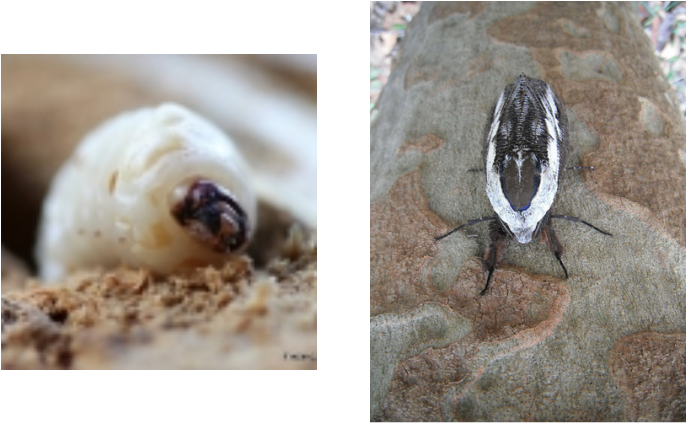Endoxyla leucomochla (Witchetty Grub)
Adaptation
E. leucomochla is very well adapted to living a life of solitude. The lack of pigment throughout the body is a result of their lifestyle as a grub. The body plan is cylindrical with a brown head and strong wood boring jaws. These specialized jaws are not for eating wood though, they are for burrowing to the roots of the bush they are born on and for keeping their chamber large enough for them to be able to turn in as they grow. While expanding their living chamber and feeding on the sap of the roots, the sawdust is mixed with silk created by the grub to fill in the opening of the hole (EcoTrainingAustralia, 2010).
As the grub grows inside the roots, which can take up to two years and grow as large as 10cm (EcoTrainingAustralia, 2010), it reaches the age to metamorph into a moth. The moth then emerges from its home and flies off. the adult moth is patterned shades of brown and grey with pale markingsforming a band along the centre of the wings. The hindwings are light brown with a reddish brown color at the base (OzAnimals.com, 2011). Both male and female moths only survive about two weeks because they do not feed in their adult forms (OzAnimals.com, 2011). Instead, the remainder of their lives as adults is used in finding mates and females laying up to 20,000 eggs at a time (EcoTrainingAustralia, 2010). To learn more about the food source and other interesting nutrition facts of E. leucomochla, head to the Nutrition page.
As the grub grows inside the roots, which can take up to two years and grow as large as 10cm (EcoTrainingAustralia, 2010), it reaches the age to metamorph into a moth. The moth then emerges from its home and flies off. the adult moth is patterned shades of brown and grey with pale markingsforming a band along the centre of the wings. The hindwings are light brown with a reddish brown color at the base (OzAnimals.com, 2011). Both male and female moths only survive about two weeks because they do not feed in their adult forms (OzAnimals.com, 2011). Instead, the remainder of their lives as adults is used in finding mates and females laying up to 20,000 eggs at a time (EcoTrainingAustralia, 2010). To learn more about the food source and other interesting nutrition facts of E. leucomochla, head to the Nutrition page.
